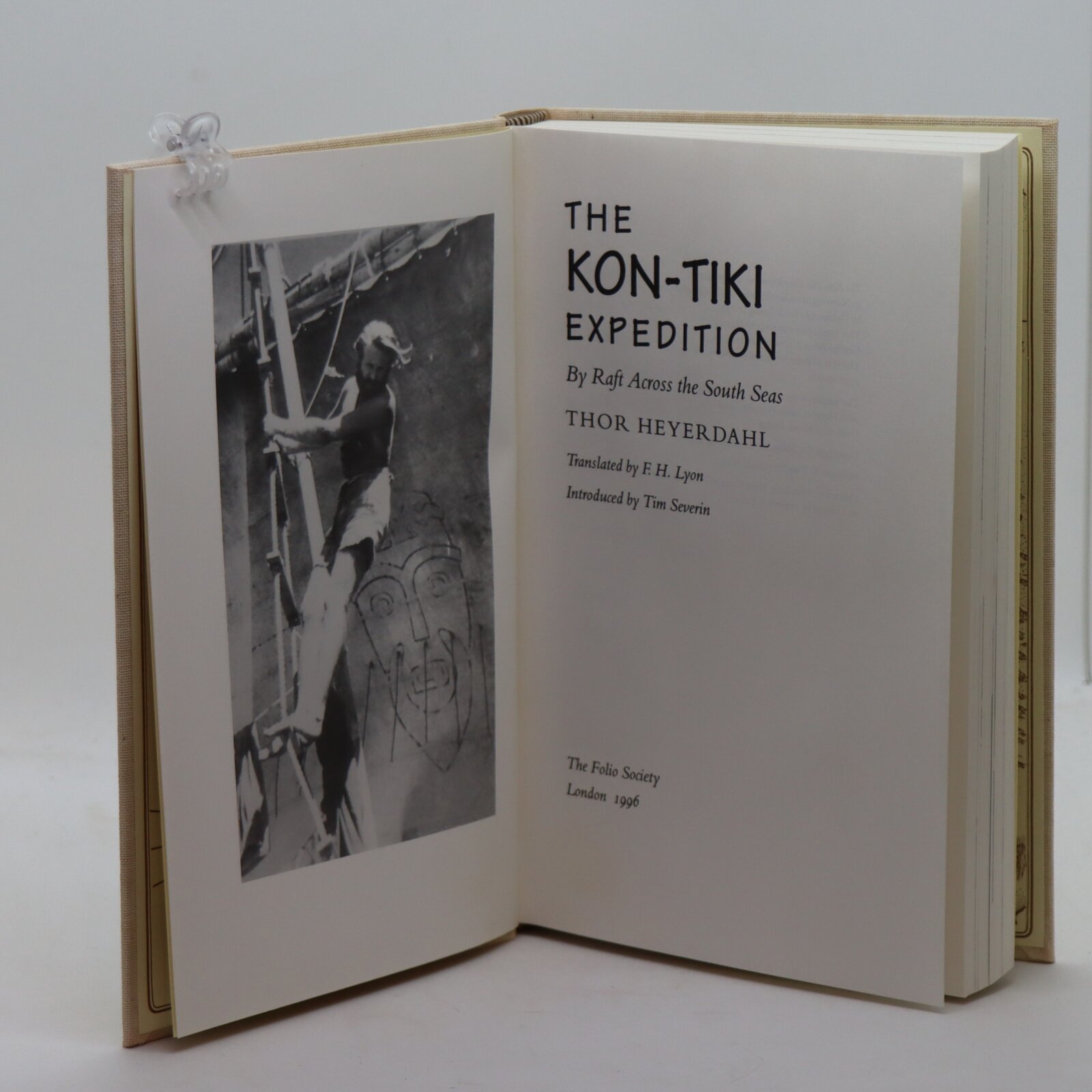The Kon-Tiki Expedition.
By Thor Heyerdahl
ISBN: 9781629146348
Printed: 1996
Publisher: Folio Society. London
| Dimensions | 16 × 24 × 3.5 cm |
|---|---|
| Language |
Language: English
Size (cminches): 16 x 24 x 3.5
Condition: Fine (See explanation of ratings)
Your items
Item information
Description
In a fitted box. Cream cloth binding with black title on the spine. Brown and black mask image on the front board.
It is the intent of F.B.A. to provide an in-depth photographic presentation of this book offered so to almost stimulate your feel and touch on the book. If requested, more traditional book descriptions are immediately available.
The Kon-Tiki expedition was a 1947 journey by raft across the Pacific Ocean from South America to the Polynesian islands, led by Norwegian explorer and writer Thor Heyerdahl. The raft was named Kon-Tiki after the Inca god Viracocha, for whom “Kon-Tiki” was said to be an old name. Kon-Tiki is also the name of Heyerdahl’s book, the Academy Award-winning 1950 documentary film chronicling his adventures, and the 2012 dramatized feature film nominated for the Academy Award for Best Foreign Language Film.
Heyerdahl believed that people from South America could have reached Polynesia during pre-Columbian times. His aim in mounting the Kon-Tiki expedition was to show, by using only the materials and technologies available to those people at the time, that there were no technical reasons to prevent them from having done so. Although the expedition carried some modern equipment, such as a radio, watches, charts, sextant, and metal knives, Heyerdahl argued they were incidental to the purpose of proving that the raft itself could make the journey.
Heyerdahl’s hypothesis of a South American origin of the Polynesian peoples, as well as his “drift voyaging” hypothesis, is generally rejected by scientists today. Archaeological, linguistic, cultural, and genetic evidence tends to support a western origin for Polynesians, from Island Southeast Asia, using sophisticated multihull sailing technologies and navigation techniques during the Austronesian expansion. However, there is evidence of some gene flow from South America to Easter Island.
The Kon-Tiki expedition was funded by private loans, along with donations of equipment from the United States Army. Heyerdahl and a small team went to Peru, where, with the help of dockyard facilities provided by the Peruvian authorities, they constructed the raft out of balsa logs and other native materials in an indigenous style as recorded in illustrations by Spanish conquistadores. The trip began on April 28, 1947. Heyerdahl and five companions sailed the raft for 101 days over 6,900 km (4,300 miles) across the Pacific Ocean before smashing into a reef at Raroia in the Tuamotus on August 7, 1947. The crew made successful landfall, and all returned safely.
Thor Heyerdahl’s book about his experience became a bestseller. It was published in Norwegian in 1948 as The Kon-Tiki Expedition: By Raft Across the South Seas, later reprinted as Kon-Tiki: Across the Pacific in a Raft. It appeared with great success in English in 1950, also in many other languages. A documentary motion picture about the expedition, also called Kon-Tiki, was produced from a write-up and expansion of the crew’s filmstrip notes and won an Academy Award in 1951. It was directed by Heyerdahl and edited by Olle Nordemar. The voyage was also chronicled in the documentary TV-series The Kon-Tiki Man: The Life and Adventures of Thor Heyerdahl, directed by Bengt Jonson.
The original Kon-Tiki raft is now on display in the Kon-Tiki Museum at Bygdøy in Oslo.
Thor Heyerdahl 6 October 1914 – 18 April 2002) was a Norwegian adventurer and ethnographer with a background in zoology, botany and geography.
Heyerdahl is notable for his Kon-Tiki expedition in 1947, in which he sailed 8,000 km (5,000 mi) across the Pacific Ocean in a hand-built raft from South America to the Tuamotu Islands. The expedition was designed to demonstrate that ancient people could have made long sea voyages, creating contacts between societies. This was linked to a diffusionist model of cultural development.
Heyerdahl made other voyages to demonstrate the possibility of contact between widely separated ancient peoples, notably the Ra II expedition of 1970, when he sailed from the west coast of Africa to Barbados in a papyrus reed boat. He was appointed a government scholar in 1984.
He died on 18 April 2002 in Colla Micheri, Liguria, Italy, while visiting close family members. The Norwegian government gave him a state funeral in Oslo Cathedral on 26 April 2002.
In May 2011, the Thor Heyerdahl Archives were added to UNESCO’s “Memory of the World” Register. At the time, this list included 238 collections from all over the world. The Heyerdahl Archives span the years 1937 to 2002 and include his photographic collection, diaries, private letters, expedition plans, articles, newspaper clippings, original book, and article manuscripts. The Heyerdahl Archives are administered by the Kon-Tiki Museum and the National Library of Norway in Oslo.
Want to know more about this item?

Share this Page with a friend













